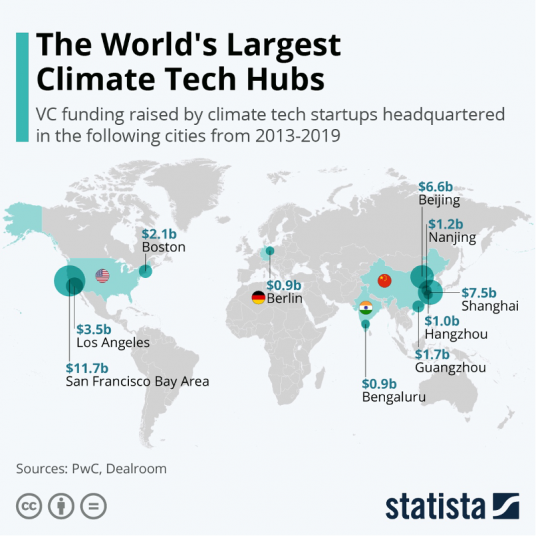
#5 Silicon Valley Going Green: Will venture capital finance a greener future?
The investor landscape in Silicon Valley is adapting to the increased demand for climate action. This week’s ‘Going Green’ article takes a closer look at the emerging green ecosystem, the role of Corporate Venture Capital, and highlights some of the relevant venture funds and their investment focus, which could be relevant for Danish start-ups.
Silicon Valley is almost synonymous with world-changing technologies and big tech companies with global impact on industries and societies. At the heart of Silicon Valley is the venture capital industry, which invests around 40 billion USD annually in innovative start-ups—70 times more than is invested in Denmark.
The venture capital model that is often associated with Silicon Valley rests on a large appetite for risk. Investments typically have a 10-year horizon, and VC firms are prepared to let a majority of their investments fail, banking on one to three out of ten investments being successful enough to cover the losses. Venture capitalists often bet large to support ‘hyper growth’ or ‘blitzscaling’ to create companies valued above 1 billion USD—the so-called ‘unicorns.’ The model has proven successful in software, internet and communication sectors, where scale can be achieved with less upfront capital investment.
So how is Silicon Valley relevant when it comes to addressing climate challenges? Silicon Valley has changed the way we consume, work and interact. Can its innovative capacity also be harnessed to transform our societies to a carbon-neutral future?
For perspective, this research shows that in 2013 the early-stage venture funding for climate tech companies was about $418 million. In 2019, total venture funding increased to $16.1 billion, a more than 3750 % increase. Source: PwC: The State of Climate Tech 2020. The next frontier for venturecapital
The Boom and Bust of Cleantech in Silicon Valley
The collapse of the cleantech sector in Silicon Valley some 10 years ago is key to understanding VC engagement with climate start-ups. In 2007, John Doerr from Kleiner Perkins, one of the most renowned VC firms in Silicon Valley, pronounced cleantech to be the business opportunity of the century, saying that “Going green is bigger than the internet.” From 2006 to 2011, VC firms invested more than 25 billion USD in cleantech start-ups. However, many of these investments failed. Nearly 150 renewable energy companies in Silicon Valley shut down, and VCs are estimated to have lost more than half of their money, causing what has been coined the ‘burst of the cleantech bubble.’ With their fingers burnt, many VCs lost interest in cleantech.
Observers have pointed out that traditional VC investments are not well-suited to cleantech. Cleantech start-ups often need longer time horizons to develop their solutions and significantly more capital to scale. They also operate in a market dominated by risk-averse legacy companies, on whom they often depend to bring their solutions to market. VCs in Silicon Valley also point to the fact that while investors have considerable expertise in growing software and biotech companies, cleantech requires a skill-set and technical know-how that was not widely available at the time.
A Second Green Wave – Enter Climate Tech?
But times are changing – again. The sense of urgency of the climate crisis has also been registered in Silicon Valley, where “climate tech” has entered the investment vocabulary. While ‘cleantech’ is still in use, the climate tech moniker covers technologies specifically aiming to reduce greenhouse gas emissions or addressing the impacts of global warming.
Nancy Pfund, founder of DBL Partners, when recently asked in a Greenbiz webinar of the differences between the first cleantech wave and now, pointed out that:
“Today, there is such a high level of focus, commitment and knowledge on the part of both the entrepreneurs, and the investors. The economics of clean technologies are extraordinarily compelling today. There has been a stunning cost reduction over the past decade, which brings in mainstream investors and asset owners, who are making dollar and cent decisions without wearing a climate banner. Also, the re-entrance of corporate investors is for real this time.”
Many of the larger VC’s are still choosing to focus on what they know best, digital technologies. However, there are signals pointing towards both well-established generalist venture capital firms and newer specialist funds zooming in on the business opportunities in climate change. Some of the large companies populating the Midas list of the world’s best venture capital investors have made statements in this regard:
- Sequoia Capital has recently called out for startups in the green space.
- Kleiner Perkins has spun out a separate Green Growth Fund, G2VP, focusing on companies using digital technologies to modernize traditional industries. They specifically focus on agriculture, energy, logistics, manufacturing and transportation sectors.
- Khosla Ventures has continued in the climate tech space, focusing on food, efficiency, power and energy storage. You can read more about Khosla Ventures here.
Khosla Ventures
Khosla Ventures was established in 2004 by the founder of Sun Microsystems, Vinod Khosla. The company is one of the renowned Sand Hill Road VC’s that have traditionally made up the backbone of Silicon Valley. It has made more than 900 investments, many of them in clean technologies.
Vinod Khosla is considered a role model for investing in climate solutions. He espouses the idea of transformative change being led by “instigators” that cause others to follow their lead. Whether these early driven entrepreneurs are successful or they fail, they will affect change by changing conventional wisdom and making the seemingly impossible possible in areas critical to climate and sustainability. Khosla Ventures invests in both early- and late-stage start-ups and is willing to take risks. Their investments are diverse and include battery technology, materials and fusion energy.
VC Funds Looking for Impact
Seeking to debunk the myth that there is a trade-off between impact and returns, there are venture capital funds like DBL Partners who are specializing in investments with big impact. They have been investing in clean technologies for decades with rates of return that outperform traditional investments. Others like Obvious Ventures and Congruent Ventures do not define themselves as impact investors, but invest in early-stage start-ups that will positively impact energy and resource consumption. You can read more about Obvious Ventures here.
Obvious Ventures
San Francisco-based Obvious Ventures is co-founded by ex-twitter CEO, Evan Williams. The firm believes it can outperform traditional venture funds by focusing on ”world positive” companies that create new solutions to big world problems in a profitable and scalable way. In an interview with VentureBeat, Williams frames the business philosophy like this;
”We’re not doing philanthropy. We’re not doing social impact investing. We’re doing early stage venture. Our thesis is that the best returns are going to come from these world positive companies.”
Obvious Ventures is a certified B Corps; a for-profit company verified for their positive impact on all stakeholders, including people and planet. Combining purpose and profit, Obvious Ventures focuses on early-stage start-ups in energy, mobility and food, and closed its first fund of USD 123,456,789 in 2015. Obvious Ventures is one of the largest shareholders in Beyond Meat, a plant-based meat substitute that just had its IPO and counts Leonardo di Caprio among its limited partners and investors.
“We all believe VC has a significant role to play in our transition to a new carbon economy by signalling interest, self-educating and making smart investments.” – Series Green
Climate change is capturing the younger generation – also in the VC community in Silicon Valley. ‘Series Green’, a new network of young VCs, exchange domain experience and knowledge on climate change and mitigating technologies. The networking initiative can also be seen as an acknowledgement that climate tech requires a different skill-set and expertise than typical software/app development. Besides sharing knowledge and concrete deal flow of green start-ups, one of the key purposes of the network is to spread the word to aspiring start-up founders that there are VCs out there very willing to invest in climate tech. Based on the need for urgent climate action, the network’s founders have an ambition to attract more talent to the entrepreneurial climate tech space and avoid all the talent being soaked up by consumer-tech.
A New Type of Patient Investors
Taking up the distinct challenges surrounding financing of climate tech start-ups, especially with hardware/deep tech solutions, a new type of venture capital investor has emerged—a patient one. Breakthrough Energy Ventures works with a 20-year timeline, focusing on funding solutions to the world’s large decarbonization challenges and measuring impact in gigatons of greenhouse gas emissions mitigated.
De-risking of climate tech is also provided by philanthropic funds, which can provide much-needed catalytic capital. While donations to mitigate climate change still only account for 2 % of total philanthropic giving in the US, donations almost doubled over the last five years to 5-9 billion USD, according to the ClimateWorks Foundation. Prime Coalition represents an interesting new trend in philanthropy using incentives inherent in the US tax code to leverage funding from endowments and rich people for innovative ventures.
Making Philanthropic Investments in Green Start-ups Less Risky
PRIME Coalition mobilizes philanthropic funding and acts as a non-profit investment syndicate to de-risk early-stage companies addressing climate change. PRIME’s novel approach lies in leveraging charitable funds from private foundations, which are required to donate 5 % of assets annually in accordance with the US tax code. It uses vehicles such as program related investments (PRIs), which have not traditionally been put to use for science and engineering innovation. The fund’s focus is to grant needed catalytic capital – patient and risk-tolerant – to technologies with the potential to mitigate gigaton-scale CO2-equivalent emissions. The early capital enables start-ups to build their technical proofs of concept which help de-risk their business by validating key proof-points necessary for later commercial investment rounds.
Since 2015, PRIME Coalition has mobilized $48.8 million and supported eleven companies, ranging from grid-scale energy storage to electric airplanes. In June 2020, the Prime Impact Fund closed 50 million USD for a new seed fund to invest in breakthrough climate tech. Celebrities Will Smith and Jada Pinkett Smith are some of the backers of Prime.
Corporate Venture Capital Is Taking Off
For climate tech start-ups, especially hardware start-ups that struggle to overcome technical, commercial and regulatory challenges while having to compete in a market dominated by large incumbents, corporate venture capital adds much-needed financing opportunities. It also provides possibilities for market validation, and access to knowledge, customers and distribution channels.
Corporate venture capital (CVC) has played a role in the investor landscape for many years. But for the first time, in 2018, CVC investment in the US overtook venture capital funds with 71 billion USD invested, according to CB Insights. This is equal to 52 percent of all VC investments.
Among the most active CVCs are tech giants such as GV (Google Ventures) and Salesforce, but CVCs with a primary focus on identifying and scaling the climate tech solutions that will transform their industries are on the rise. The incumbents have joined the game.
In 2018 and 2019, the top 5 oil and gas CVCs participated in deals worth more than 1 billion USD. Shell Technology Ventures is the most active of these, followed by Saudi Aramco, Total, BP and Chevron. Driving their investments is the potential of discovering new low-carbon fuels, renewable energy sources and other environmentally friendly technologies, which match their current business or present opportunities for diversification.
Green Funding from the Oil and Gas Companies
New alliances and partnering models are also entering the VC market. The Oil and Gas Climate Initiative (OGCI) is an example of oil and gas companies gathering in a consortium to accelerate industry response to climate change. The initiative has a 1 billion USD fund investing in solutions to decarbonize oil and gas, industrials, and commercial transport. An example of a recent investment is in the Mountain View-based company Kairos Aerospace that utilizes airborne and spaceborne sensors to e.g. detect methane leaks. Furthermore, OGCI is among the active investors in carbon removal projects, having funded projects both in the US and globally. Energy Impact Ventures, built around an alliance of utilites, represents an interesting corporate venture model.
Bringing VC, Utilities and Start-Ups Together
Energy Impact Partners (EIP) is a collaborative strategic investment firm working with 14 utilities to back cutting-edge energy technology companies at the growth stage. The fund raised $681 million in its first fund (when?) and is aiming for 750 mio. USD for its second fund. EIP invests globally and has 3 offices in the US (incl. San Francisco) and 3 in Europe.
EIP is also establishing itself in Norway by partnering with Nysnø, a sovereign climate investment company administered by the Norwegian Ministry of Trade, Industry and Fisheries.
EIP approaches strategic venture investing by bringing incumbents, investors and entrepreneurs together. Utility partners benefit from insights on emerging technologies and business models to help them prepare for the future. Portfolio companies benefit from unique access to a broad group of global customers that can accelerate their growth making them more successful. This reduces risk in the investments and maximizes return for investors. EIP’s portfolio includes technologies such as microgrid, EV charging infrastructure and grid storage technologies, as well as automation and analytics platforms.
An Ecosystem That Is Maturing
Scaling and deploying the solutions needed to mitigate climate change requires a diverse set of actors and funding models. A cornerstone of Silicon Valley’s ecosystem is this plethora of experienced VC funds with a proven track record in scaling start-ups. Even if the ‘traditional’ Silicon Valley is still predominantly about IT and digital solutions, parts of the VC community are jumping on board the climate bandwagon—a development that is likely to experience only more tailwind with the younger generation of investors entering VC. There are signals of a more comprehensive ecosystem developing, which can accommodate the diverse funding needs of innovative climate tech companies on their perilous journey from idea to transformational solution. And with digital technologies being part and parcel of a carbon neutral future, Silicon Valley remains centre stage as part of the green transition.
How Danish Start-ups Can Benefit
Denmark has key business strongholds in climate/cleantech, world class researchers and entrepreneurs. With ambitious climate goals, strong policy drivers, green investments and innovative public-private climate partnerships, the Danish ecosystem for green technologies is growing and offers many benefits to startups needing to test their solutions in a smaller setting. However, for start-ups entering the growth and scaling phase, and in need of more paths to risk-willing capital and international strategic partners, the heightened focus on climate tech and the maturing green ecosystem in Silicon Valley is good news. Danish corporates looking for green technologies to achieve sustainability goals may also find what they are looking for in Silicon Valley. Reach out to Innovation Centre Denmark to learn more about this.
This article was written by The Innovation Centre Denmark in Silicon Valley and is brought to you as a part of the ‘Silicon Valley Going Green’ series in collaboration with the Innovation Centre.













Comments